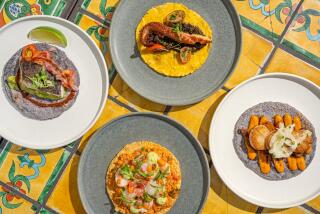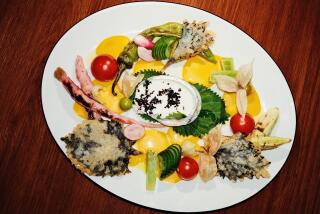Nice Has a Style and Air of Romance All Its Own
- Share via
NICE, France — During this year’s bicentennial celebration of the French Revolution you’ll see and hear much of Marianne, the legendary heroine who waved the tricolor as she led insurgents against the troops of Louis XVI.
But Nice has its own military heroine, Catarina Segurana, who during a 16th-Century attack by Turks mounted the town ramparts and dispatched a couple of Barbarossa’s troops with her carving knife.
Catarina then spun on her heels, lifted her skirts and flashed total contempt toward the retreating infidels, a feat that caused locals to dedicate an enormous bas-relief plaque to the intrepid damsel.
Nice has always had a full measure of Catarina’s verve and derring-do, and an air of romance that caused Napoleon to propose to his landlord’s daughter on a visit here.
And why not? Its location on the ever-blue Baie des Anges is one of France’s most spectacular settings, and the town’s style can best be described as a year-round celebration, what with the renowned Nice Carnival, the Battle of Flowers, the concerts and jazz festivals and the costume parades and other hoopla that go on most of the time.
Toss in 15 art galleries, the Chagal, Matisse and a dozen other fine museums, plus a flower market in Old Town that alone is worth a visit, and you realize why Nice should be on anyone’s itinerary of southern France.
Getting here: Fly Air France nonstop to Paris or UTA nonstop from San Francisco. Several American and foreign carriers also fly to Paris with changes. Air France and Air Inter will get you to Nice in about an hour.
How long/how much? Our latest visit was three days and that seemed too short. Nice is loaded with good hotels in all price categories. Also a gamut of fine restaurants, but the prices can get scary.
A few fast facts: A dollar recently bought six francs. Visit any time from February’s carnival until year’s end. July-August is terribly crowded, September-October lovely. Le Petit Train leaves every 20 minutes to make the rounds of important stops in town (with guide) for about $3 U.S., with on-and-off privileges all day.
Getting settled in: The Primotel Suisse (15 Quai Rauba Capeu; $43-$51 double, a suite for four at $82) has the best view in town from the east end of Baie des Anges. It’s anything but a motel, being a small older hotel that was renovated this year. Bedrooms are small, but freshly decorated in light blue and white, with fine baths.
Plaisance (20 Rue de Paris; $38-$50 double, depending upon season) is in the heart of the shopping district and very popular. Again, rooms are small, but you get most of the amenities: hair dryer, TV, air conditioning and a room safe. Breakfast only. The manager is affable.
Hotel Nicea (6 Rue Miron; $41-$47 double) is in the same neighborhood as Plaisance and also serves breakfast only. Small bedrooms are very neat and fresh, but most only have showers. Take the old-fashioned cage elevator up to the sixth floor for a drink on the terrace overlooking the town.
Regional food and drink: Nice is rightfully known for its salad nicoise , a refreshing mix of cooked and raw vegetables capped with anchovies, tuna, black olives, capers and egg slices.
Pissaladiere is a pizzalike tart of fried onions, anchovies and black olives. Just as favored is pan bagnat , an enormous sandwich bun filled with most of the salad nicoise ingredients and sprinkled with oil and vinegar.
Another local specialty is socca , a pancake made of chickpea flour and either baked with bread crumbs and cheese topping or fried in olive oil. And there’s a variety of fresh seafood.
Good dining: La Belle Nicoise (in the Old Town flower market) is the place to head if you want all the Nice specialties. It’s built into the old city walls, with vaulted ceilings kept bright by pastel colors, green vines climbing the walls and rustic blue furniture.
The $15 menu we sampled offered fish soup or mussels, then a fillet of hake, mixed fried fish or an entrecote, followed by chevre or a dessert. Everything was prepared beautifully.
La Baieta is the place for fish and other seafood in all its forms. You’ll find 20-plus varieties straight from the grill, pan or oven, plus bouillabaisse. Dine inside or outside in the evening.
The brand-new La Reale (Primotel Suisse) is built into the walls of an old castle across from the bay. Crisp white linen and fresh carnations, and the menu presents three courses of assorted classic French dishes. A fine place.
Going first-class: Hotel Beau Rivage (24 Rue St. Francois de Paule; $133 double) is a perfectly run hotel with a wonderful location, total comfort and superb dining.
Beau Rivage is a step from its own private beach, with a restaurant by the water, another in the hotel that served us one of the best meals of our trip and a cooking school run by the renowned Roger Verge, who also supervises the restaurants.
Henri Matisse stayed here and painted “My Room at the Beau Rivage” in 1917. Director Pierre Constant came onto the scene much later, but he runs his hotel with the same deft hand, preserving a lightness of feeling and color that the painter achieved.
Negresco (37 Promenade des Anglais; $216-$332 double) is the Grand Dame of Nice hotels, a turn-of-the-century palace as ornate outside as in. But what impressed us most was its Chantecler (one star) restaurant and new chef, Dominique Le Stanc. Le Stanc has cooked in seven restaurants with a total of 15 Michelin stars, most of them in clusters of twos and threes, and all by the age of 30.
We shan’t forget the cannelloni stuffed with a fricassee of lobster, black olives, fennel and herbs. The pasta was made with finely ground black olives in the dough. Or a round of paper-thin potato slices layered and grilled with scallops, leeks and truffles. A fantastic meal.
Elysee Palace (59 Promenade des Anglais; $130) is the brightest new star on Nice’s hotel horizon, a modern-as-tomorrow place with gorgeous rooms and rooftop pool that still retains much of the intimacy and personal service of a small hotel.
On your own: Hop Le Petit Train for an overview of the town and its sights, then return to the colorful markets of Old Town, perhaps for lunch in one of its many good restaurants.
We particularly enjoyed a stop at Nice’s oldest shop for olives, oil, mountain honey and assorted herbs: Huiles d’Olives Alziari at 14 Rue St. Francois de Paule. And just around the corner, Caves Caprioclio is the town’s oldest wine seller, with an endless display of Provencal wines from $2 on up.
Stop at a tourist information office (5 Ave. Gustave V; another at the airport) for a brochure on Nice’s museums and galleries. Deciding which to visit is a difficult choice in this art-rich city.
For more information: Call the French Government Tourist Office at (213) 271-6665 and 272-2661, or write to 9454 Wilshire Blvd., Suite 303, Beverly Hills 90212 for a map/brochure of southeast France, including Nice.
More to Read
Sign up for The Wild
We’ll help you find the best places to hike, bike and run, as well as the perfect silent spots for meditation and yoga.
You may occasionally receive promotional content from the Los Angeles Times.






